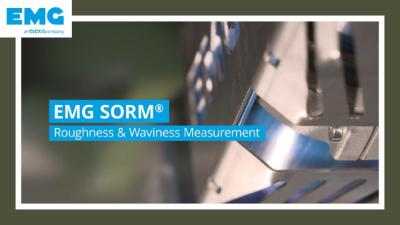
In the rapidly evolving world of manufacturing flat metals such as steel and aluminium, ensuring a high quality and defined surface texture is essential, particularly in the production of high quality automotive and white goods surfaces. The online measurement of roughness and waviness parameters in hot dip galvanizing and continuous annealing lines determines product quality and production yield. EMG Automation GmbH has addressed this need with the EMG SORM® system, an innovative solution that allows the continuous measurement of surface roughness and waviness, providing online data for process optimisation and control tasks. This article delves into the technical approach of EMG SORM® and its impactful application in these critical production lines.
The Technical Edge: Non-Contact Measurement at Production Speed
Traditional surface roughness measurements rely on mechanical stylus instruments, which require the production line to halt or necessitate offline sample testing. These methods are not only time-consuming but also lack the statistical significance needed for modern manufacturing standards. EMG SORM® revolutionizes this process by providing a non-contact, online measuring system capable of functioning at production speeds up to 350 m/min.
The system utilizes a confocal chromatic measurement principle, where different wavelengths of light focus at different distances, allowing for precise measurement of the strip’s micro profile. This data is used to calculate key roughness parameters such as Ra (arithmetic average roughness), RPc (peak count), and Wsa (waviness). By integrating this solution into a production line with a traversing unit, EMG SORM® provides continuous roughness and waviness monitoring across the entire width and length of the strip, ensuring comprehensive surface quality assessment.
Application in Hot Dip Galvanizing and Continuous Annealing Lines
In hot dip galvanizing lines, where the metal strip is coated with zinc or alloys, the control of surface roughness is vital for both the adhesion of the lacquer coating and the optical appearance of the final product. The same is true for in continuous annealing lines. EMG SORM® excels in these environments by offering online data that enables operators to detect and correct deviations immediately.
The system's ability to perform online visualization and recording of roughness and waviness parameters allows for immediate corrective actions, optimizing the rolling and skin-pass processes. This capability not only enhances product quality but also reduces costs by extending the service life of work rolls and minimizing rejects during subsequent quality assessment procedures.
Maximizing Production Efficiency and Quality
The implementation of EMG SORM® offers numerous advantages that lead to a short return on investment (ROI). Its capability of immediate detection of roughness and waviness deviations ensure that potential issues are addressed before they impact the final product, leading to a significant reduction in customer complaints. Moreover, EMG SORM® can contribute to a more efficient and cost-effective production process by optimizing the skin pass mill control and thus ensuring a homogeneous surface quality.
For those interested in improving their production line's surface quality control, EMG SORM® represents a significant technological advancement. The system's flexibility in installation, minimal space requirements, and ease of integration make it an ideal choice for modern manufacturing lines for flat metals products.
Contact Details
Related Glossary Terms
- alloys
alloys
Substances having metallic properties and being composed of two or more chemical elements of which at least one is a metal.
- annealing
annealing
Softening a metal by heating it to and holding it at a controlled temperature, then cooling it at a controlled rate. Also performed to produce simultaneously desired changes in other properties or in the microstructure. The purposes of such changes include improvement of machinability, facilitation of cold work, improvement of mechanical or electrical properties and increase in stability of dimensions. Types of annealing include blue, black, box, bright, full, intermediate, isothermal, quench and recrystallization.
- flat ( screw flat)
flat ( screw flat)
Flat surface machined into the shank of a cutting tool for enhanced holding of the tool.
- milling machine ( mill)
milling machine ( mill)
Runs endmills and arbor-mounted milling cutters. Features include a head with a spindle that drives the cutters; a column, knee and table that provide motion in the three Cartesian axes; and a base that supports the components and houses the cutting-fluid pump and reservoir. The work is mounted on the table and fed into the rotating cutter or endmill to accomplish the milling steps; vertical milling machines also feed endmills into the work by means of a spindle-mounted quill. Models range from small manual machines to big bed-type and duplex mills. All take one of three basic forms: vertical, horizontal or convertible horizontal/vertical. Vertical machines may be knee-type (the table is mounted on a knee that can be elevated) or bed-type (the table is securely supported and only moves horizontally). In general, horizontal machines are bigger and more powerful, while vertical machines are lighter but more versatile and easier to set up and operate.
- quality assurance ( quality control)
quality assurance ( quality control)
Terms denoting a formal program for monitoring product quality. The denotations are the same, but QC typically connotes a more traditional postmachining inspection system, while QA implies a more comprehensive approach, with emphasis on “total quality,” broad quality principles, statistical process control and other statistical methods.
- surface texture
surface texture
Repetitive or random deviations from the nominal surface, which form 3-D topography of the surface. See flows; lay; roughness; waviness.
- waviness
waviness
The more widely spaced component of the surface texture. Includes all irregularities spaced more widely than the instrument cutoff setting. See flows; lay; roughness.







